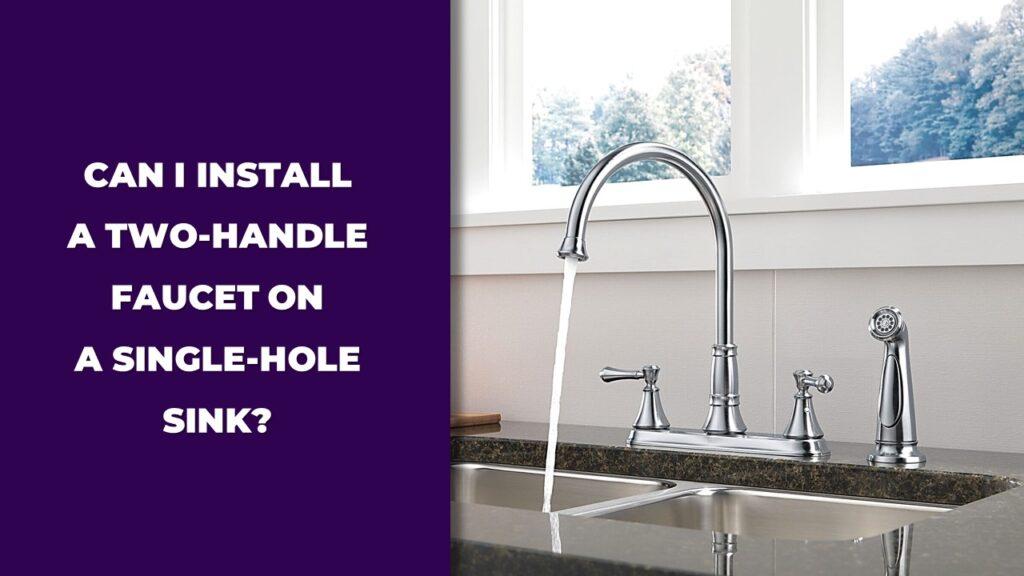
Yes, you can install a two-handle faucet on a single-hole sink, but only if the faucet is made for it. These models have a wide baseplate that combines both handles and the spout into one unit, letting them fit through a single hole. Inside, the faucet mixes hot and cold water just like a standard two-handle setup.
Standard two-handle faucets won’t work without drilling extra holes, which isn’t ideal for sinks made of stone, porcelain, or fireclay. Choosing a faucet labeled “single-hole compatible” is the safest and simplest option.
This article will cover how these faucets work, what to watch out for, pros and cons, and when you might need a plumber’s help.
What Is a Single-Hole Sink?
A single-hole sink has just one pre-drilled hole, typically designed for a faucet that controls both water temperature and flow from a single spot. This setup is common in small bathrooms, bar sinks, and modern kitchens where space is tight and design is minimal.
Single-hole sinks keep things simple—there’s no need for extra holes for separate handles or sprayers. The single opening is usually centered and works perfectly with faucets that have an integrated mixing valve. If you’ve got a compact vanity or a slim countertop, a single-hole sink makes the most sense for a clean, functional look.
How Do Two-Handle Faucets Usually Work?
Two-handle faucets typically require three holes: one for the spout in the middle and two separate holes for the hot and cold handles. Each handle connects to its own water supply line, letting you control the hot and cold flow independently. This setup gives precise control over water temperature but takes up more counter space.
These faucets are a go-to choice for traditional bathrooms, larger vanities, and homeowners who like the classic look of separate knobs or levers. They can be a challenge for single-hole sinks though, as you’d usually need to drill extra holes or buy a specialized model designed for single-hole installation.
Specially Designed Two-Handle Faucets for Single-Hole Sinks
Two-handle faucets for single-hole sinks are special designs that combine both handles and the spout into one compact base. They let you enjoy the look and feel of a two-handle setup without drilling extra holes in your sink or countertop.
These faucets are a smart solution for small sinks or minimalist spaces where you want both hot and cold control but only have one mounting hole available. They’re made to fit single-hole sinks straight out of the box, saving time and avoiding costly sink modifications.
What Are They and How Do They Work?
- A single-hole two-handle faucet has a wide deck plate or base that holds both handles and the spout in one unit.
- Inside the faucet, a mixing valve blends hot and cold water, so you still get separate handle control without needing separate holes.
- These models are often used in retrofits where drilling isn’t an option or when you want a classic look on a modern sink.
- They connect to standard supply lines like regular faucets, so installation is usually straightforward if your sink hole is the right size.
Why Are They Not Common?
- Fewer brands make them, so style and finish options are limited.
- They can cost more than standard single-handle faucets because of their specialized design.
- Some homeowners find the wide base too bulky for small sinks.
- Many people aren’t aware they exist, so they stick with single-handle models by default.
- Retailers often don’t carry them in stock, so you might have to order online or from a specialty supplier.
Can You Convert a Standard Two-Handle Faucet to Fit a Single-Hole Sink?
Yes, you can drill extra holes in your sink to install a standard two-handle faucet, but it’s risky, and usually not worth it. Drilling into materials like porcelain, granite, or fireclay can easily lead to cracks or permanent damage. Even if you manage to get the holes right, you might void your sink’s warranty or run into alignment issues with the faucet.
This kind of modification also requires the right tools, steady hands, and experience. If you’re even slightly unsure, a small mistake could leave you with a ruined sink or an expensive repair. Most bathroom and kitchen sinks just aren’t made to be altered after installation, especially the molded or glazed ones.
A safer and simpler solution is to choose a two-handle faucet made for single-hole sinks. These models have both handles and the spout mounted on a shared baseplate, so they install with no extra drilling. You still get the look and function of separate hot and cold controls, without risking damage or unnecessary hassle.
Method 1: No-Drill Installation Using Specially Designed Two-Handle Faucets
You can install a two-handle faucet on a single-hole sink without drilling—if the faucet is specially designed for it. These faucets combine both handles and the spout into a single, wide base that fits right into one hole. Inside, an internal mixing valve controls hot and cold water, just like a regular two-handle faucet.
If you’re looking for a safer, simpler solution, especially in rentals or remodels, this method lets you enjoy the look and function of two handles without damaging your sink.
What Are Single-Hole-Compatible Two-Handle Faucets?
Some two-handle faucets are built specifically for single-hole installation. These models come with a few key features:
- Wide Baseplate Models: The faucet’s base is wider and often covers the space that traditional three-hole sinks would use. It supports both handles and the spout in one unit. This design keeps the faucet stable while also covering any cosmetic gaps.
- Internal Mixing Valve Functionality: Inside the faucet, there’s a valve that mixes hot and cold water before it flows out. Each handle controls one water line, and the mixing happens inside the faucet body itself, no extra plumbing required.
Pros of No-Drill Option
- No Risk to Sink Surface: You don’t have to cut into stone, porcelain, or any other sink material. Just drop the faucet into the existing hole and tighten it down.
- Easier, Cleaner Install: No dust, noise, or need for special tools. It’s similar to installing a single-handle faucet.
- Great for Renters and DIYers: It’s ideal if you want to upgrade your faucet without making permanent changes or hiring a plumber.
Cons of No-Drill Option
- Limited Availability: Not every brand or store carries this style. You may need to shop around or order online.
- Bulkier Appearance: The wide base can look oversized on smaller sinks or minimalist vanities.
- Higher Price Than Standard Faucets: Since these are specialty items, they usually cost more than basic single-handle models.
Step-By-Step Installation (No Drilling)
Tools Needed
- Adjustable wrench
- Basin wrench (optional, for tight spaces)
- Plumber’s tape
- Silicone sealant (if no gasket is provided)
- Towels or small bucket (to catch water)
Full Steps from Water Shutoff to Final Leak Test
- Turn Off Water Supply: Shut off both hot and cold valves under the sink. Open the faucet to drain any remaining water.
- Remove the Old Faucet: Disconnect the supply lines and unscrew the mounting nuts. Lift the old faucet out carefully.
- Clean the Mounting Area: Wipe away any old sealant or mineral buildup so your new faucet sits flat.
- Install the New Faucet: Position the faucet in the sink hole. If there’s a rubber gasket, use it. If not, apply a small bead of silicone under the baseplate.
- Secure from Underneath: Use the mounting hardware provided to tighten the faucet from below. Make sure it sits level.
- Connect the Water Supply Lines: Use plumber’s tape on the threaded connections and tighten the lines to the hot and cold valves.
- Turn On the Water and Test for Leaks: Slowly open the water valves. Check under the sink and around the base for any drips.
- Seal the Base If Needed: If there’s any gap between the base and the sink, apply a thin line of silicone around the edge and wipe away the excess.
Method 2: Drilling Additional Holes to Fit a Standard Two-Handle Faucet
You can install a standard two-handle faucet on a single-hole sink, but only if you’re willing to drill extra holes, and it’s not always a safe move. Some sink materials can handle drilling, like stainless steel or laminate. Others, like porcelain or granite, are more fragile and can crack easily. If done right, this method opens up more faucet options, but it takes the right tools, careful planning, and sometimes professional help.
Here’s everything you need to know before deciding to modify your sink.
Can You Drill a Sink for Faucet Installation?
Adding holes to a sink is possible, but only if the material allows for it.
- What Materials Allow Drilling: Sinks made from stainless steel, laminate countertops, or solid surface materials are usually safe to drill with basic tools and the right bit.
- Materials to Avoid Modifying: Porcelain, fireclay, cast iron, granite, and quartz are much harder to drill. These surfaces are brittle and can crack or chip, even with diamond-tipped tools. Drilling into them is risky and often not worth the cost of a mistake.
Risks of Drilling
- Cracking the Sink: A single wrong move can ruin the entire sink. This is especially common with porcelain or natural stone.
- Voiding Warranties: Most manufacturers will not cover damage caused by modifications like drilling.
- Difficulty Aligning Holes Correctly: Faucet handles need to be spaced evenly. If the spacing is even slightly off, the faucet may not fit or sit straight.
Pros of Drilling
- More Faucet Style Options: You’re not limited to specialty models. You can choose from any standard two-handle faucet available.
- Allows Reusing an Existing Two-Handle Faucet: If you already have a faucet you love, this method lets you keep using it, even if your new sink only has one hole.
Cons of Drilling
- High Risk of Permanent Damage: If the sink cracks, you might have to replace the entire thing.
- Requires Specific Tools and Skills: You’ll need proper drill bits, patience, and a steady hand to avoid slipping or overdrilling.
- Often Needs Professional Help: For stone or porcelain sinks, a licensed plumber or contractor may be the safest route.
Step-By-Step Overview (If Drilling Is Chosen)
Tools Required
- Power drill
- Diamond-tipped or carbide hole saw
- Painter’s tape or masking tape
- Measuring tape and marker
- Safety goggles and gloves
- Silicone sealant
- Your faucet template (often included in the box)
Precaution Checklist Before Drilling
- Confirm your sink material can be drilled
- Read the sink’s warranty terms
- Place masking tape over drilling spots to prevent slipping
- Support the underside of the sink to reduce vibration
- Wear safety gear at all times
How to Measure and Mark Correct Spacing
- Use the faucet’s installation guide or template
- Most standard faucets have 4 to 8 inches between handle holes
- Mark the center hole, then measure out evenly from both sides
- Double-check measurements before drilling—there’s no going back once you start
How to Choose the Right Two-Handle Faucet for Your Single-Hole Sink
Here’s how to choose the right two-handle faucet for a single-hole sink:
- Check for “single-hole compatible” or “single-hole mount” on the product specs
- Look for a wide baseplate design that holds both handles and spout
- Measure your sink hole to make sure it matches the faucet’s base
- Pick a finish and style that suits your bathroom or kitchen
- Consider ease of cleaning—fewer grooves mean less buildup
- Check warranty and customer reviews for long-term reliability
Choosing the right faucet is about more than just style. Look for models that clearly say they work with single-hole sinks, as not all two-handle faucets are built that way. Measure your sink’s hole size, especially if you have a smaller vanity. Some faucets have a wide base that can look too bulky on compact sinks. And if you care about long-term performance, stick with trusted brands that offer solid warranties. That way, you can enjoy your faucet without worrying about leaks or constant maintenance.
Common Mistakes to Avoid
Here are the most common mistakes to avoid when installing a two-handle faucet on a single-hole sink:
- Using a regular two-handle faucet instead of one designed for single-hole sinks
- Forgetting to measure your sink’s hole size and baseplate width
- Over-tightening the connections, which can damage the faucet or sink
- Skipping leak tests after installation
- Ignoring water supply line compatibility
- Not checking the manufacturer’s manual for specific installation instructions
Taking the time to avoid these mistakes can save you from costly repairs, leaks, or a faucet that just doesn’t fit right. Remember, even small details like the thickness of your sink or the placement of the faucet can make a big difference in the final result.
When It’s Time to Call a Plumber
If the installation feels confusing, the sink material is delicate, or you run into leaks, it’s time to call a plumber. Sometimes, it’s better to let a professional handle the tricky parts—especially when working with stone, porcelain, or older plumbing setups.
Plumbers have the right tools and experience to make sure your faucet is installed safely and works as it should. If your sink wasn’t designed for a two-handle faucet or you’re unsure about cutting holes, a plumber can help you figure out the best solution without risking damage. And if leaks or water pressure issues pop up during installation, a pro can quickly spot and fix the problem before it gets worse.
Conclusion
So, can you install a two-handle faucet on a single-hole sink? Yes, but only if you choose the right faucet that’s designed for a single-hole setup. These special faucets combine both handles and the spout into a single base, so you get the classic two-handle look without drilling extra holes.
If you’re shopping for a new faucet, make sure to double-check the specs. Look for models labeled “single-hole compatible” and pay attention to the baseplate size and style. That way, you’ll get a faucet that fits perfectly and adds the design touch you’re after.
Remember, if you’re not comfortable with plumbing work, don’t risk damaging your sink or faucet—call a plumber. A good faucet should make life easier, not harder, and getting the right fit is key to a leak-free, long-lasting setup.
Related FAQs
Can I Just Drill Extra Holes in My Sink to Fit a Two-Handle Faucet?
Technically yes, but it’s risky. Drilling into porcelain, stone, or fireclay can crack the sink, ruin the finish, or void your warranty.
Are Two-Handle Faucets for Single-Hole Sinks as Durable as Standard Models?
Yes. As long as you buy from trusted brands and install it properly, a two-handle faucet designed for a single-hole sink will last just as long.
Do I Need a Deck Plate for a Two-Handle Faucet on a Single-Hole Sink?
Most two-handle faucets made for single-hole sinks include a wide baseplate that covers the area, so you typically won’t need a separate plate.
Will a Single-Hole Faucet Adapter Help?
No. Faucet adapters are not designed to convert a standard two-handle faucet to fit a single-hole sink. You’ll need a faucet made specifically for that setup.

Dylan Foster is a family man with years of hands-on experience in plumbing, household maintenance, and fixing everyday issues around the home. A former plumber, Dylan knows what it’s like to deal with tricky leaks, worn-out parts, and all the little problems that pop up in a house. From plumbing repairs to kitchen fixes and garden hose setups, he’s done it all. Dylan shares real-world solutions to help others keep their homes running smoothly and avoid costly mistakes.




